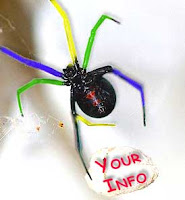DARWIN’s Information Organic Network (ION)
We are all familiar with the power of web-published information networks; the URL cross-referencing web pages through its authors. We are also familiar with social networks driven by the desire to include friends, families and colleagues to keep each other informed. Both models have created part of the incredible value we get from the Web. Google could not deliver its ranked results without cross-referenced URLs, andt Facebook or LinkedIn could not expend their business reach without the social networks they capture.
Theses models are making the internet an unavoidable necessity for all. However, both models depend on the content authors to create links to other content and be linked to from other pages, and for people to invite and be invited to join networks. Basically the networks are built from the deliberate actions by Web actors. Is there an other type of network? The semantic Web? Surely but it is a framework for organizing concepts. It too requires human interventions to be useful.
Perhaps there is an other type of network that escapes the control of human control; an organic network of information? DARWIN’s use of chaos theories looks at the information captured on the web as connected through human cognition. If the human cognition is the environment for information genesis, then human cognition is the only media capable of decrypting the patterns that emerge from an unstructured and chaotic generation of content. By human cognition, we mean the thoughts contained within the content itself, and not the actions of humans on the content after it has been created.
The concept may appear esoteric, but Edward Norton Lorenz’s work in the advent of super computers in the 70s proved that chaos mathematical models reveal observable patterns in weather. In a similar way DARWIN looks at chaotic information and human cognitive as the key ingredients capable of displaying the patterns that reveal the existence of an Information Organic Network. Unlike the web-page and social networks, this network does not require human intervention to be organized; it is self-organizing and therefore more representative of what is happening as it occurs. Such a network of information provides a neutral awareness about what is happening, as well as making serendipitous discoveries easier to observe by its user.
The content organizes itself rather than being organized by human intervention or external algorithms. This eliminates the possibility of spam or clever SEO manipulation. Darwin’s approach lets the connections within the content emerge. Darwin them visualizes these connections so a person can use their own cognitive abilities to determine what is important and explore what is relevant to them. Each person can make their own sense of the content on the Web, rather than have an external force organize it for them as Google does. Darwin simply distills what is happening in a way that allows for the individual human cognition to take over.
Theses models are making the internet an unavoidable necessity for all. However, both models depend on the content authors to create links to other content and be linked to from other pages, and for people to invite and be invited to join networks. Basically the networks are built from the deliberate actions by Web actors. Is there an other type of network? The semantic Web? Surely but it is a framework for organizing concepts. It too requires human interventions to be useful.
Perhaps there is an other type of network that escapes the control of human control; an organic network of information? DARWIN’s use of chaos theories looks at the information captured on the web as connected through human cognition. If the human cognition is the environment for information genesis, then human cognition is the only media capable of decrypting the patterns that emerge from an unstructured and chaotic generation of content. By human cognition, we mean the thoughts contained within the content itself, and not the actions of humans on the content after it has been created.
The concept may appear esoteric, but Edward Norton Lorenz’s work in the advent of super computers in the 70s proved that chaos mathematical models reveal observable patterns in weather. In a similar way DARWIN looks at chaotic information and human cognitive as the key ingredients capable of displaying the patterns that reveal the existence of an Information Organic Network. Unlike the web-page and social networks, this network does not require human intervention to be organized; it is self-organizing and therefore more representative of what is happening as it occurs. Such a network of information provides a neutral awareness about what is happening, as well as making serendipitous discoveries easier to observe by its user.
The content organizes itself rather than being organized by human intervention or external algorithms. This eliminates the possibility of spam or clever SEO manipulation. Darwin’s approach lets the connections within the content emerge. Darwin them visualizes these connections so a person can use their own cognitive abilities to determine what is important and explore what is relevant to them. Each person can make their own sense of the content on the Web, rather than have an external force organize it for them as Google does. Darwin simply distills what is happening in a way that allows for the individual human cognition to take over.


Comments